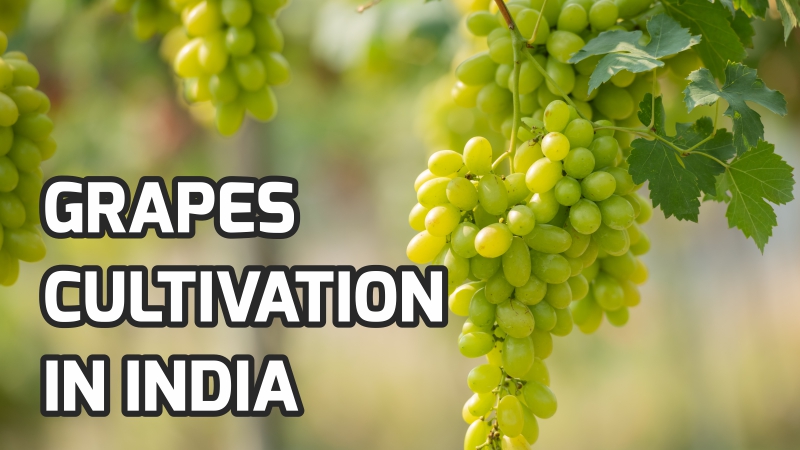Introduction to Grapes:
In various states of India, grapes farming is a significant agricultural industry. If properly managed, grape production can be quite profitable. This comprehensive guide includes information on how to start a grape plantation in India, as well as detailed information on the climate, soil, varieties, plant protection, management, harvesting, and post-harvest procedures.
Grapes, a member of the Vitaceae fruit family, are farmed for commercial purposes all year round in India. It is grown from north to south of the peninsula of India, from Punjab, Madhya Pradesh, Haryana, J & K, Mizoram to Maharashtra, Karnataka, Tamil Nadu, Andhra Pradesh, and Kerala. It is adapted to tropic, subtropical, and mild-tropical climate conditions. Among them, Maharashtra and Tamil Nadu play a significant role in the nation’s overall production.
Fruit value and uses of grapes:
According to a study, a cup of grapes contains 90 calories without any fat, cholesterol, or sodium. Its 20% sugar content is natural, abundant in calcium, wealthy, and full of various vitamins and nutrients. The color of grapes makes them rich in antioxidants, polyphenols, and fiber, all of which have significant health advantages, in addition to being a fantastic source of vitamins C and K. More than 80% of the grapes grown worldwide are used to make wine, while 10% are prepared for the food and raisin sectors and the remaining 20% are utilized for table usage. Even though India’s share of the grape export market is very small, the pace is growing.
Indian grape cultivation
A perennial bush with helices, tendrils, and trails the grape plant has helices. The vine-like grape is a climbing plant. On stems, the tendrils degenerated inflorescences grow.
The leaves have a heart-shaped form. They are large and set across from one another. They have noticeable nerves. The variety affects the leaves color, size, and form.
There are variations with and without seeds. Up to 4 seeds per fruit are possible with the seeded variant. 4–6% of seeds contain tannins.
Soil requirement for grape cultivation in India:
Grape cultivation is possible in a variety of soil types.
The best soil is sandy loam to loamy soil with high organic matter drainage. Lower than pH 8.7 is ideal for soil. It should have up to 20% lime concentration and up to 10% calcium carbonate.
Poorly draining alkaline soils are not suitable.
Process of Planting Grapes:
- The soil is prepared by tilling. As grapevines are typically planted in pits, the spacing between the pits is prepared appropriately. Pits range in depth from 60 to 90 cm.
- The type and variety of the training system affect the pit’s spacing.
- Before planting, the pit must be ready and left open for 30 days.
- For north India, the best planting season is between February and March. For peninsular India, between November and January.Tamil Nadu and Karnataka during December and January.
- Monsoon season is typically avoided for grape growing.
- 10-15 days after planting, the grape plant starts to grow. In comparison to the cold season, warm season grape growth begins earlier.
- The plants need staking and training just a month after planting.
Typically, trenches are used to plant the grapevines. The distance between the vines as well as the particular needs of the variables affects the pit’s size. Depending on the type of soil, the depth can range from 60 to 90 cm. For robust types like Anab-e-Shahi and Bangalore Blue, a wider spacing (1.2 m X 1.2 m) is needed. The Thompson Seedless, Perlette, and Beauty Seedless types call for a little smaller area (90 X 90 cm). The spacing used for Thompson seedless and its mutations in central Maharashtra and northern Karnataka is 1.8m X 2.4m. Open the 2.5-foot-deep and 2.5-foot-wide trenches along the desired length in the north-south direction.
At the very least a month before planting, this should be done. The suggested distance between rows is between 9 and 10 feet. Topsoil, FYM, green manure, super phosphate, etc. should be added to the trenches, and they should be liberally watered. A month before planting, the pits must be opened. Open the trenches at the desired red planting distance for planting (5 – 6 ft for table grapes). To prevent transplanting shock and field mortality, immediately plant the rooted cuttings in the opened pits and irrigate them. Typically, planting is avoided when it’s raining.
Irrigation Seems to need:
Different regions have different irrigation methods. It relies on the monsoon cycle, the soil’s ability to retain water, the variety, the training method, and the spacing.
Water the newly planted crop in the vineyard once every three days.
A single emitter is installed at the vine base in drip irrigation cases. The amount is then raised to 2 and ultimately to 4.
After pruning, a lot of irrigation is applied to hydrate the entire root zone and encourage active development.
Grape crops need mild irrigation in intervals of 10 to 12 days during the winter.
The following irrigation is skipped or postponed in the event of rain.
In order to improve fruit quality, irrigation frequency is reduced throughout fruiting, anthesis, and after berry softening.
The yield of grape cultivation:
Plants in North India begin to bear fruit two years after they are planted. Early variety berries start to ripen at the end of May. However, the majority of the types are picked once they have turned delicious and changed color at the tip. The broken, decaying, malformed, and undersized berries are taken out a day before harvest. In order to avoid temperatures rising above 20° C, the clusters are often picked in the morning.
To Know more about Grapes farming and other crops, install the KhetiGuru application that provides you with all agricultural information and also gives you expert advice for farming-related problems. To get the tractor, tractor price related information visit the KhetiGaadi website.




